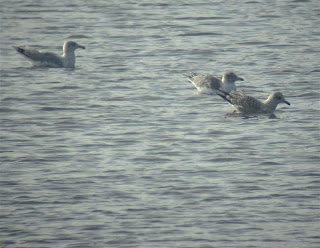Past records have included Tundra Bean, Barnacle, Brent, White-fronted and Pink-footed Geese as well as the regular Greylags, Canadas and Egyptian Geese.
There have also been escaped/feral Emperor and Bar-headed Geese, and a Chinese Swan Goose put in an appearance on one occasion.
Personally, I still haven’t seen Bean Geese or wild Pink-foots locally and have only recorded Brent Goose on one occasion over the years.
After the unidentified gull from yesterday failed to appear this morning at Water Colour lagoons (more on that in a minute), I was about to head further round the local patch when I noticed a smallish goose heading in from the north-east and splash landing onto the lagoon.
A BRENT GOOSE no less.
I guess I shouldn’t have been so surprised as there have been Brents over Canon’s Farm at Banstead and Beddington SF, where one touched down briefly, in the past week or two.


The Brent soon teamed up with a few Mallards and headed to the far bank of the lagoon, where it dabbled around in the shallows for about five minutes, before being spooked by the noisiest jogger in the area - a chap that you can hear coming from a mile away (exaggeration) by his loud huffing, puffing and grunting.

Not surpringly, the Mallards and Brent took off in a panic and the goose circled the lagoon calling persistently before heading off to the west. A new bird for the year at Holmethorpe.
I wandered further round the local patch and after checking the pits at Spynes Mere and Mercers West, I headed back across Mercers Farm when I noticed it, or another, Brent heading towards me from the west. It circled over Mercers Farm before heading back toward Mercers West Pit and out of sight.

Despite the lousy photo, I can assure you that it was a Brent Goose!
The only other bird of note appeared as I was watching a flock of 15 Lesser Redpolls (still no Commons found locally) and the flock suddenly took off in a panic as a male PEREGRINE flew overhead heading east.
Two decent birds in a day will do just fine, so I headed back to the Water Colour lagoons to check the gulls again. Still no sign of yesterday’s oddity.
So far there have been three suggestions as to what the gull was (Azorean Yellow-legged Gull, a small argentatus Herring Gull or a very pale graellsii Lesser Black-backed Gull) but, as the photos were so poor, we will probably never know for certain, unless it appears again.
My money is on it being a small female argentatus Herring Gull.
I can only hope that it is seen at Beddington SF where the birders are far more experienced at gull identification than any of the Holmethorpe birders.
Graham












